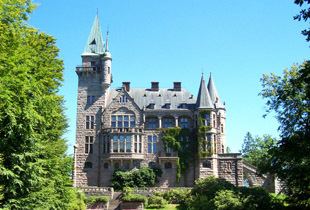Elevation 167 m (548 ft) Local time Wednesday 3:04 PM | Time zone CET (UTC+1) Population 65,345 (31 Dec 2015) | |
 | ||
Weather 10°C, Wind W at 31 km/h, 50% Humidity Points of interest | ||
Växjö ([²vɛkːɧøː]) is a city and the seat of Växjö Municipality, Kronoberg County, Sweden. It had 63,479 inhabitants as of 2013, out of a municipal population of 85,000. It is the administrative, cultural, and industrial centre of Kronoberg County and the episcopal see of the Diocese of Växjö. The town is home to Linnaeus University.
Contents
- Map of VC3A4xjC3B6 Sweden
- Fall semester 2015 v xj campus sweden
- Etymology
- History
- Environmental policy
- Notable locations
- Climate
- Sports clubs
- References
Map of V%C3%A4xj%C3%B6, Sweden
Fall semester 2015 v xj campus sweden
Etymology
The city's name is believed to be constructed from the words "väg" (road) and "sjö" (lake), meaning the road over the frozen Växjö Lake that farmers used in the winter to get to the marketplace which later became the city.
History
In contrast to what was believed a century ago, there is no evidence of a special pre-Christian significance of the site. The pagan cultic center of Värend may have been located at Hov, a nearby village.
An episcopal see since the 12th century, the city did not get its city charter until 1342, when it was issued by Magnus Eriksson. During the Middle Ages, Växjö did not have many pious institutions. A Franciscan monastery was established in 1485. An hospital of the Holy Ghost was first mentioned in 1318. In the 14th century Växjö got its first school, Växjö katedralskola. In 1643 it received gymnasium status.
At the beginning of Gustav Eriksson's war of liberation, the peasantry joined forces, under the guidance of the union-hostile bishop Ingemar Pedersson, with the mountain men and peasantry of Dalarna, Hälsingland, and Gästrikland, who urged fidelity to their leader Gustav Eriksson. During the Dacke War, a peasant uprising, the city was under the authority of Nils Dacke and his supporters from the summer of 1542 until after New Year 1543.
Several times during the Northern Wars and the Scanian Wars, and thereafter, the city was affected by fire (in 1277, 1516, 1570, 1612, 1658, 1690, 1749, 1753, 1799, 1838 and 1843). After the last fire in 1843, when 1,140 citizens were rendered homeless, Växjö received its current street plan.
The Barbarella nightclub was prominent in southeastern Sweden in the 1970s, attracting several major international bands.
Växjö is the city in which the famous "Kvinnan med handväskan" photograph was taken in 1985 by Hans Runesson.
Environmental policy
In 1996 the city adopted a policy for the elimination of the use of fossil fuels by 2030. This decision was taken in reaction to pollution and eutrophication in the lakes that surround the town. Greenhouse gas emissions were cut by 41% from 1993 to 2011, and were reduced by 55% by 2015. The city's economy has grown during this time.
By 2014, Växjö's CO2 emissions had dropped to 2.4 tonnes per capita, well below the EU average of 7.3 tonnes.
Notable locations
The city has three municipality-run secondary schools ("gymnasiums"): Teknikum, Katedralskolan, Växjö, and Kungsmadskolan. Linnaeus University had a student body of 42,000 students as of 2012.
Industries include Alstom and Aerotech Telub, as well as Volvo Articulated Haulers which is located in Braås 29 kilometres (18 miles), north of Växjö. One of the best-known service providers is Visma. Växjö houses Sweden's National Glass Museum and claims to be the capital of the "Kingdom of Crystal" as well as of the "Kingdom of Furniture".
The Swedish Emigrant Institute was established in 1965 and is housed in the House of Emigrants near Växjö Lake in the heart of the city. It contains archives, a library, a museum, and a research center relating to the emigration period between 1846 and 1930, when 1.3 million (or 20%) of the Swedish population emigrated, mainly to the United States. Archives dating to the 17th century contain birth and death records, as well as household records, that are available on microfiche.
Immediately north of Växjö is Kronoberg Castle, a ruined fortress constructed in the 15th century. This castle was used as a base by the rebel, Nils Dacke, during the Dacke War. The fortress has thick walls and artillery portals that face north towards lake Helgasjön. Teleborg Castle is also located near the city. It was built near the Linnaeus University in the year 1900 as a morning (wedding) gift. Teleborg Castle now functions as a hotel and conference facility.
Since 2016, Fortnox Arena has held a video game speedrunning event in July. The event aims to raise money for the Save the Children charitable foundation. Over 400 attendees are expected to turn up for ESA 2017.
Climate
Växjö has an oceanic climate. It is milder, wetter, and cloudier than the rest of the country, with the number of hours of sunshine being associated more with the British Isles than with areas further north in Sweden. Considering its relative distance to all three coasts surrounding South Sweden, the climate is markedly marine, with winter temperatures being relatively low for an inland location. Temperatures have risen in recent years, and for the 1961–1990 reference period Växjö was almost humid continental; however, under the standard Köppen classification, it is well within the oceanic range for the 2002–2015 period. When compared with sunnier inland areas further north, Växjo has relatively cool summers.
Sports clubs
The following sports clubs are located in Växjö:
